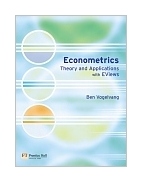|
||
• wydawnictwa polskie
• Zamów informacje o nowościach z wybranego tematu • kontakt
• Cookies na stronie |
ECONOMETRIC THEORY AND APPLICATIONS WITH EVIEWSVEGELVANG B.wydawnictwo: FT/PH , rok wydania 2005, wydanie Icena netto: Economists are regularly confronted with results of quantitative economics research. Econometrics: Theory and Applications with EViews provides a broad introduction to quantitative economic methods, for example how models arise, their underlying assumptions and how estimates of parameters or other economic quantities are computed. The author combines econometric theory with practice by demonstrating its use with the software package EViews through extensive use of screen shots. The emphasis is on understanding how to select the right method of analysis for a given situation, and how to actually apply the theoretical methodology correctly. The EViews software package is available from 'Quantitive Micro Software'. Written for any undergraduate or postgraduate course in Econometrics. Features
Table
of Contents PART ONE: PREPARATORY WORK 362 pages
Po otrzymaniu zamówienia poinformujemy, |


